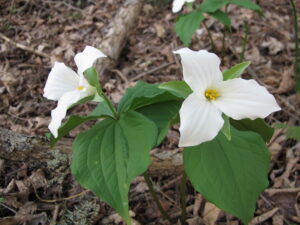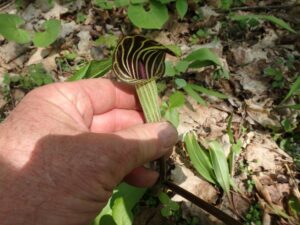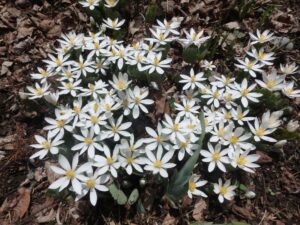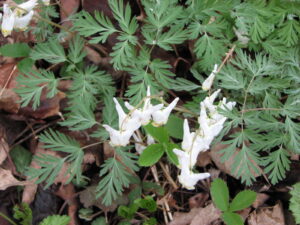Six Wildflowers You Should Grow
Posted on Tuesday, May 5, 2020 · Leave a Comment
I love wildflowers. Right now several species are blooming in my woods, and others are on their way. They are a demure smile before the serious romance of summer blossoms in the main gardens. But after winter, they are loved as much as the bodacious peonies and brilliant poppies that will come later.

White trillium or Trillium grandiflorum
One of my favorites is Trillium. That is both a scientific name and a common name, though the common wine red species, Trillium erectum, is also called Purple Trillium, Wake-robin and Stinking Benjamin. It does best in light shade and acidic soils. Its flower has three petals and stands up above the foliage. As it matures over the years, the clumps get bigger. A related species, T. grandiflorum, or white trillium is similar in looks, but with white petals that fade to pink. It’s very lovely.
Another favorite of mine is Jack-in-the Pulpit ( Arisaema triphyllum). The flower has a hood over a “preacher” that is hidden inside. It is designed so that little flies will crawl down inside the flower, pollinating it as they go. It has both male and female parts, but only one or the other are fertile at a time, to prevent self-pollination. They grow well in woodlands, in deep rich acid soil. As the plants grow older, they get larger, sometimes reaching two feet tall.

Jack in the pulpit
Hepatica is one of the earliest wildflowers to bloom in my woods. The common name, Hepatica, is also the scientific name, though there are two similar species: H. acutiloba or Sharp-lobed Hepatica, and H. americana or Round-lobed Hepatica.
Hepatica grows in light shade, and does best with a few hours of sunshine. They do best in rich, dark, humusy soil. They form tidy clumps, each about the size of a big African violet. The blossoms are numerous: an old clump in my woods has about 50 one-inch wide lavender flowers on it now, each with six petals. This plant does not spread much, so buy enough to make a statement.
Bloodroot is a beauty that spreads well by root, though is never obnoxious about it. This fabulous wildflower has blossoms similar to those on Hepatica, but bigger, and white with a yellow center. The blossoms are quite ephemeral, blooming and then littering the ground some days later with petals. The flowers close up at night (when pollinators are sleeping) or on cold, rainy days.

Bloodroot likes good drainage and more sun than most wildflowers
The leaves are dramatic. When they first appear, they are rolled up like a cigar, standing vertically in your forest duff. Later the leaves open and flatten out, getting large for a wildflower: six to eight inches wide. These persist much of the summer, creating a nice groundcover.
Bloodroot gets its name from the red liquid it oozes if you break a root. You can propagate the plant by diving roots when dormant in the fall and planting in light shade or morning sun in moist, well-drained soil.
Another of my favorites is Dutchman’s breeches ( Dicentra cucularia). This is a true spring ephemeral: it produces flowers and leaves, and then everything disappears after a few weeks until next year. It is in the same genus as Bleeding Heart, a dramatic pink or white June-blooming perennial. The flowers are white, and look like little pants hanging upside down, with several flowers on each stem.

Dutchman’s breeches
The foliage is as pretty as the flowers: it is finely cut, and reminiscent of its cousin, wild bleeding heart ( Dicentra exemia) which is sold everywhere as a shade perennial. When Dutchman’s Breeches dies back, the leaves just disappear without yellowing and lingering on, which is a nice feature. It does best in moist, rich soil in shade or part sun. The corms are tiny.
Finally, you should have some trout lily or Dog-toothed Violet ( Erythronium americanum). This diminutive plant has nice spotted leaves and spreads like a groundcover in shady, humus-rich woods. But in the wild, they bloom infrequently, and only after they have two leaves – and most of mine have just one. The flowers are yellow on 4 inch stems.
So how do you get started? Most garden centers do not sell these plants, and seeds are not readily available – and often need to be planted right after picking. You should not dig them up in the wild and doing so is prohibited in most states.
I called Barry Glick of Sunshine Farm and Gardens in Renick, West Virginia. His farm is 60 acres of flowers at 3,650 feet of elevation, so Zone 5. He agreed to put together a package of the plants I have featured here, three plants of each, ready to go in the ground for $89.10 as a special deal for my readers. They will be shipped free by Priority Mail. E-mail him at
barry@sunfarm.com for details and tell him I sent you.
In interest of full disclosure, Barry sent me a set of plants for free, but I am not profiting from his sales. The plants (or bulbs or corms without leaves) are not huge, but are 3 to 5 years old, and ready to bloom next year. They come in half gallon Ziplock bags, packed in peat moss and ready to plant. All mine looked great, and I planted them in an open woodland with rich soil.
So think about getting some wildflowers, and remember you shouldn’t just go dig them up in the wild! Wildflowers bring me great joy when they bloom, and I bet they will please you, too.






